BLOG
BLOG


AIR BnB Adventure! - 7 different stays over 2 weeks
April 2025
My husband and I decided to go 'up the East Coast' as far as Port Stephens and came back via the Blue Mountains. It involved staying at 7 different Air BnB's at Lakes Entrance, Tilba, Kiama, Terrigal, Port Stephens, the Blue Mountains and just outside of Cobram.
The accommodation at each location varied greatly from a tiny house on a farm, to a 'Shed' in Kiama, to a Townhouse in Terrigal, a stunning view property in Anna Bay, to just a room in the Blue Mountains. We like to mix things up a bit!
Every place was completely different and charming in its own way, and the pluses were fabulous hosts, cute and quirky entrances, stunning views and a few unexpected, but highly appreciated, treats!
There were also some definite NO NO's including old dishevelled towels and a bed that felt like we were sleeping on a divan base rather than a mattress!
Most places these days get it right, but there is often room for improvement, and as we found, it was the little things that count., though a comfy bed is essential!

Hamptons
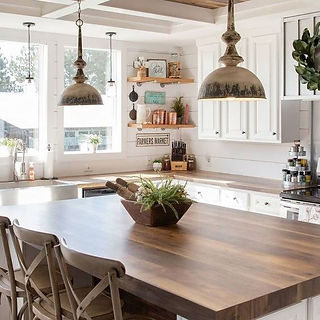
Country

Industrial

Eclectic

Coastal

Contemporary
Finding Your Style
7 November 2022
Firstly, everyone's home interior style is different!
No two people have exactly the same taste - even Interior Designers and identical twins Alyssa and Lyssandra (The Block) have their own styles. We may LOVE a certain look but when it comes down to the finer detail, there will be differences in lighting, colours, homewares and art that we select which gives us our own SIGNATURE look.
So, when choosing an interior style, it's important to identify first what OVERALL LOOK you'd like to achieve... Here's an indicator of the top 8:
1. Contemporary - very 'now' with contrasting and complimentary colours and textures with on trend furnishings and art.
2. Coastal - Beachy, light and airy
3. Hamptons - Classic, elegant and welcoming.
4. Retro - Referring to an earlier period eg mid century
5. Traditional - Incorporates Antiques and reflects 18th & 19th Century colour palettes and furnishings.
6. Provincial - elegant furniture from the Provinces of France, linens and cotton, and soft colours.
7. Industrial - Textural recycled brick with black windows and cladding, timber or polished concrete flooring.
8. Country - Rustic or modern farmhouse style. Can be light and airy with a contemporary look or highly textural and detailed with panelling or exposed brick and stone.
9. Resort - Rich timbers, plantation shutters and palms to create that Bahamas or Maldives look.
10. Glamour - Bling! Marble, Mirrors, lots of glass and high end finishes such as gold taps.
11. Eclectic - Combination of styles such as bohemian and coastal.
And the list goes on!
But first, start by EXPLORING these styles to see which style most resonates with you.
CHOOSE up to two styles which you love the look of and start up a Pinterest Page to collect 'Pins' of those images you most love.
SELECT only images that you absolutely love and take note of the materials used (marble, stone, timber), the furniture style, and the colours.
HONE your style by selecting your top 6 bathroom, kitchen, bedroom, living, dining, exterior looks etc and move these to your favourites folder on Pinterest.
By now you'll start to see a pattern emerge of what colours, textures and looks you like.
If you find you like too many different things from each style, go back to the beginning and hone your style first, choosing only two. This helps narrow your focus.
Remember, your eventual style can be a mix of styles and colours, but this process works if you can select one or two, then explore textures, materials and colours within that style.
Finally, discuss styles with your partner to share ideas and come to a mutually agreeable style for your renovation or new home project.
For more inspiration, see my PINTEREST pages on 'Home Interior Styles'
Good Luck!
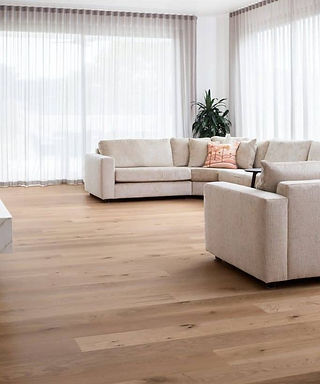
HARD FLOORING - OPTIONS, PROS & CONS
HARD FLOORING - OPTIONS, PROS & CONS
11 April 2022
With so many options to choose from, I've highlighted the top 4 used in most Aussie homes and the pros and cons of each:
1. ENGINEERED TIMBER
What it is: 4mm REAL timber veneer mounted to plywood with a total thickness of between 13-16mm depending on the product. Planks come in varying lengths and widths with one strip or two strips of timber (per plank) options.
Comes in a range of Australian and European timber species such as Spotted Gum, Blackbutt, Tasmanian Oak, European Oak, Ironbark and Brush Box to name a few.
PROS: The look of solid timber planks without the expense.
CONS: Water left for long periods will warp the ply and damage the timber so attend to liquid spills quickly.
MAINTENANCE: Treat the same as you would a real timber floor - use felt feet under furniture legs to avoid scratching. Avoid high heel shoes which can damage the surface.
2. HYBRID / RIGID CORE FLOORING (PLANKS & TILE LOOKS)
What it is: A floating floor that looks like timber flooring or tile but in fact consists of multiple layers for ultimate water protection - see image below.
PROS: Vast number of colours planks and tile look designs. Very easy maintenance and great for families with pets.
With the limestone core, this product is super water resistant.
CONS: Typically needs scotia/quad trim up against skirting boards to provide an expansion gap, however you can add skirting boards AFTER installation to avoid this. Large areas need expansion joints, otherwise floor can be seen to lift as it is a 'floating' floor.
3. LUXURY VINYL PLANK - LVP OR LVT (GLUE DOWN)
What it is: A bendable Vinyl plank made to look like real timber. Ideal for quick installation glued down directly to slabs or over tiles (once a leveller is applied). Thicknesses are either 2mm to 4.5mm thick, making it an easy install product. It is simply glued straight down to your prepped and level floor.
PROS: Fantastic for families, commercial spaces, rental properties and over tiles or damaged floors where masonite can create a new level surface prior to installation. Any damaged 'planks' can be easily removed and replaced by simply taking up and installing a new plank.
Joins are barely visible. Extremely water resistant.
4. LAMINATE
Laminate is what many homes are familiar with as a term for flooring and it does differ greatly from Hybrid flooring. Laminate flooring has a wear layer, design layer (image), HDF (High density fibre board) base and finally a 'balancing' layer which helps stop it from bowing - see image below. Comes in various plank lengths, widths and thicknesses.
CONS: It does not have the built in underlay (like Hybrid does) so it doesn't perform as well accoustically and you get that click-click sound when you walk on it. Nor does it have the waterproof limestone core (that Hybrid does). However make sure you ask for the newer type of laminate with HYDROSEAL technology, which now provides better water protection.
CONTACT ME FOR BROCHURES ON RECOMMENDED PRODUCTS.
* Images below are examples as a guide only. Flooring suppliers will each have slightly different layer construction.

Laminate Example

Hybrid Example
photo by Karndean

Engineered Example

Luxury Vinyl Plank Example
photo by Karndean Flooring

M I N I M A L I S M - less STUFF means more SPACE!
M I N I M A L I S M - less STUFF means more SPACE!
10 September 2021
There is a new movement called Minimalism and a fascinating documentary film about this new way of looking at what we have in our homes and how having too much actually takes something away from how we live.
I was enthralled by this and it certainly made me think differently about what I buy, and why, in future.
why LESS is MORE….
Less 'stuff' means more space.
Less stuff means more money (especially if you sell your old or unwanted stuff).
Less stuff means more freedom and time spent outdoors in nature, rather than in shops.
Less stuff means buying QUALITY rather than QUANTITY.
THE MINIMALIST 30 DAY CHALLENGE…
Some friends told me of this 30 day minimising plan which I thought was wonderful.
On day 1, you remove one item from your home you no longer need. On day 2, two objects, day 3, three objects and so on until you reach 30 days, by which time you will have removed a massive 465 items from your home! WOW!
Of course, there are plenty of other less drastic ways to minimise our carbon footprint:
Swap paperback books for a Kindle = MORE shelf space!
Stream movies rather than buy them = MORE storage!
Buy larger refill containers of grocery items such as handwash refills, detergents and shampoo which minimise plastic waste, and simply refill your existing bottles = MORE Eco friendly! 😊
Finally, I confess I am guilty of just as many waste issues and bad eco choices as the next person, but I am always prepared to learn about better ways to live, love and enjoy my life, plus pay it forward to the planet I live in.
MUST WATCH FILM: The Minimalists: Less is Now (Netflix)

P E R F E C T L Y P O T T E R Y . . .
P E R F E C T L Y P O T T E R Y . . .
10 August 2021
As we finally come out of lockdown in regional Victoria, it's fair to say we may have been feeling a bit potty and ready to break free.
Well, it's no secret that I love hand made pottery, vases, cups and dinner ware.
In fact, pretty much anything hand made is a thing of beauty to me.
The fact that someone has taken the time to design and create something useful, and beautiful, provides a constant source of wonder, with the talent of the individual really shining through.
We have so many talented artists and ceramicists living right on our doorstep that I thought I'd share some of their work with you.
Take a peak at Elizabeth Bell's work from Geelong West (elizabethbellceramics.com), Anni Stevenson from Jan Juc (Instagram: From The Clay), IKIGAI (Geelong West) and Chandra Paul's from Clunes (ChandraPaulCeramicArt) - demonstrating the diversity of styles in ceramics.
You can also visit The Australian Ceramics Community online and visit their directory which lists ceramicists by State so you can explore to your hearts content.
Of course anything handmade or homemade is about as Eco friendly as you can get, and it brings so much joy to your home.
PHOTO: IKIGAI Pottery, Geelong West

K E E P I N G I T R E A L . . .
K E E P I N G I T R E A L . . .
10 July 2021
Indoor plants have been popular for centuries providing shade when there were no such thing as curtains, providing food on your doorstep, and kept on hand for all sorts of remedies and herbal medicines.
Whilst there has been a huge craze for fake plants in recent years, nothing beats the real thing – a living, breathing, growing, glowing, plant.
As well as providing something decorative to help fill a lonely corner, or pop on a shelf, or even suspend from the ceiling, a house plant brings nature indoors, purifies the air of your home naturally and is something wonderful to nurture and watch grow.
A home project could be to make your own macrame plant holder, or repurpose an old basket. There are loads of ideas on Pinterest.
Faux plants can look great yes, but ultimately they will end up as landfill – of the non-decomposing variety (not a pretty sight) - whereas the real deal will decompose naturally, replenishing the earth with nutrients.
So perhaps the next time you’re thinking of adding a bit of greenery, try to keep it real.
Your planet, and your new plant, will thank you for it.
PHOTO: Indoor Jungle Book by Lauren Camilleri & Sophia Kaplan.
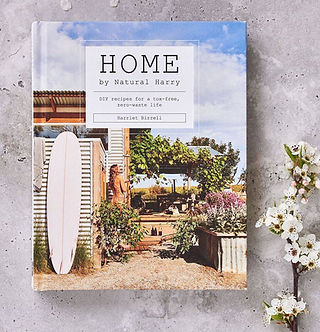
D E T O X - B o d y , S o u l & H o m e
D E T O X - B o d y , S o u l & H o m e
10 June 2021
There are many books, blogs, magazines and websites nowadays about how to detox your body, calm your mind and live earth friendly at home, but what I always love to share is something LOCAL.
You’ve probably already heard of our very own local Barwon Heads gal Harriet, who wrote the books Natural Harry and Whole by Natural Harry, and more recently Home by Natural Harry.
As described on her website, HOME by Natural Harry ~ is ‘a comprehensive collection of DIY recipes, tips, tricks and hacks for a calm, resourceful and tox-free existence’. It includes kitchen recipes, cleaning recipes and is the perfect accompaniment to her other recipe-based books.
I bought this book for a dear friend and I don’t think I’ve ever had such a rapt response to a gift.
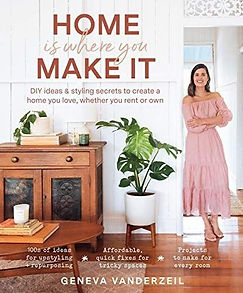
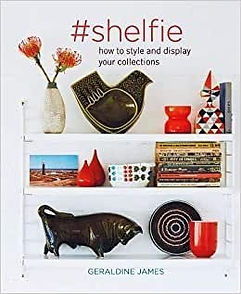

L O V E L Y R E A D S . . .
L O V E L Y R E A D S . . .
10 May 2021
Home is Where You Make It by Geneva Vanderzeil, whose home is beautifully renovated and decorated using mostly secondhand furniture and recycled or upcycled décor.
She also shares DIY projects.
This is a gem of a book and lovely read for people wanting sustainable and affordable ideas whether a renter or home owner.
#Shelfie, by Geraldine James
Fantastic tips on styling your shelves and displaying collections.
The imagery is beautiful and appeals to all people with a penchant for collectibles or just wanting to create visually interesting shelf displays. Lots of tips here!
Plant Style, How to Greenify your space
by Alana Langan and Jacqui Vidal.
A gorgeous book full of ideas for styling, grouping and displaying plants, as well as plant varieties suitable for indoors.
The perfect coffee table book!
Plant Tip: Not all indoor plants are pet friendly! Make sure you check if your current plants are potentially harmful / toxic to your pet.
